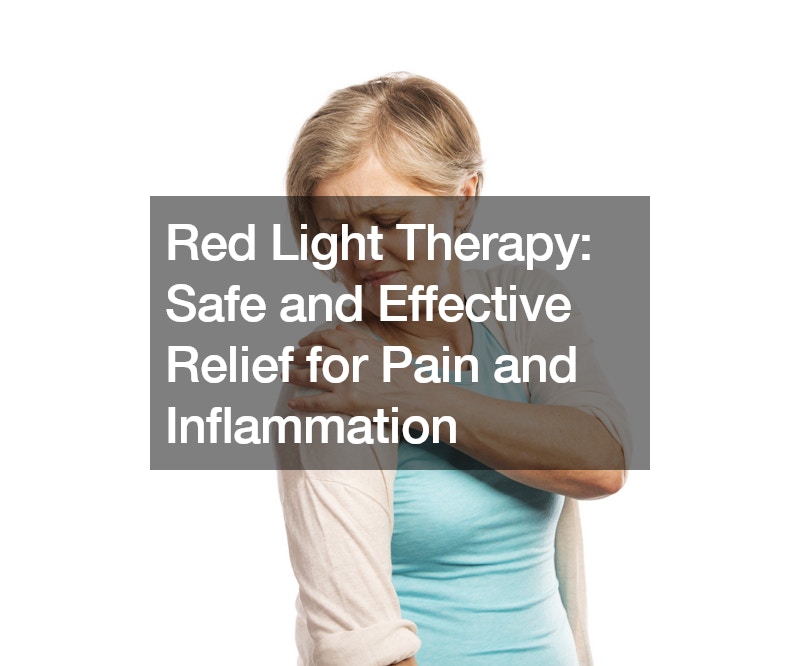
Chronic pain and inflammation are widespread issues affecting millions of people worldwide. Traditional treatments often involve medications with potential side effects. Fortunately, research is exploring promising alternative therapies like red light therapy. This article delves into red light therapy, exploring its effectiveness in managing pain and inflammation, along with considerations for treatment.
Understanding Red Light Therapy
Red light therapy, also known as photobiomodulation, utilizes specific wavelengths of red light to interact with cells in our body. When cells absorb these light photons, they experience a boost in metabolism. This triggers a cascade of beneficial cellular responses, including increased cell proliferation and migration, reduced inflammation, and the formation of new blood vessels (angiogenesis). These cellular changes translate into real-world benefits for pain management and tissue healing.
Clinical Evidence for Pain Relief
Clinical trials have shed light on the effectiveness of red light therapy in treating various pain conditions. Studies on knee osteoarthritis, a common degenerative joint disease, have shown that red light therapy helps reduce pain and disability compared to placebo treatments. The benefits seem to be long-lasting, with improvements continuing even after treatment ends.
Furthermore, red light therapy has demonstrated positive results in managing pain associated with tendon disorders like tennis elbow and rotator cuff tendinopathy. It has also proven helpful in alleviating neuropathic pain, a type of nerve pain that can be challenging to treat.
Professional Treatment vs. Home Devices
Red light therapy can be administered in two main settings: professional healthcare facilities and at-home using personal devices.
Professional healthcare facilities, such as physical therapy clinics and chiropractic offices, often utilize high-powered lasers for red light therapy. These lasers deliver concentrated doses of light to targeted areas, potentially leading to faster and more effective treatment. Additionally, healthcare professionals can personalize treatment plans based on individual needs and conditions.
At-home red light therapy devices, typically Light Emitting Diode (LED) panels, offer a more affordable and convenient option. However, they have limitations. Compared to professional lasers, LEDs have a broader light spectrum and emit a more divergent beam. This makes it challenging to deliver the same level of concentrated energy to the treatment area.
Safety and Considerations
Red light therapy is considered a safe treatment with minimal to no side effects. In rare cases, people might experience mild discomfort during treatment or temporary skin redness at the treatment site. These side effects typically resolve quickly.
It’s important to note that red light therapy is still a developing field of medicine. There are ongoing investigations into optimal dosing protocols and the relative efficacy of lasers versus LEDs. Additionally, treatment guidelines for specific conditions are still being established.
Who Can Benefit from Red Light Therapy?
Red light therapy offers a promising alternative for individuals seeking non-invasive and drug-free pain management solutions, particularly for conditions like:
- Osteoarthritis: As mentioned earlier, red light therapy has shown effectiveness in reducing pain and improving joint function in osteoarthritis patients.
- Tendonitis: This therapy can be helpful in managing pain and inflammation associated with various tendon disorders.
- Muscle Recovery: Athletes and active individuals can potentially benefit from red light therapy’s ability to promote tissue repair and speed up recovery after exercise.
- Chronic Pain: Red light therapy shows promise in managing chronic pain conditions, but further research is needed to determine its effectiveness for specific pain types.
Integrating Red Light Therapy into Your Treatment Plan
While red light therapy offers exciting possibilities, it’s crucial to remember it’s not a standalone treatment. It should be incorporated as part of a comprehensive pain management plan that may also include:
- Exercise: Regular physical activity strengthens muscles, improves flexibility, and aids in joint health.
- Nutrition: A balanced diet rich in essential nutrients promotes healing and supports overall well-being.
- Physical Therapy: Physical therapists can provide targeted exercises and manual therapy techniques to address specific pain sources and improve mobility.
Exploring Red Light Therapy as an Option
If you’re interested in exploring red light therapy for pain management, it’s essential to consult your healthcare provider. They can discuss your individual situation, determine if red light therapy is suitable for you, and recommend the most appropriate treatment approach. If considering professional treatment, inquire about the type of red light device used and the provider’s experience with this therapy.
For at-home use, research reputable brands and devices with adjustable settings. Remember, while home devices offer convenience, professional treatment might be more effective due to targeted delivery and personalized treatment plans.
Conclusion
Red light therapy emerges as a promising alternative for pain management, backed by growing scientific evidence. Its safety profile and non-invasive nature make it an attractive option for many. However, it’s important to manage expectations and understand that red light therapy works best when integrated into a comprehensive treatment plan. Consulting a healthcare professional to discuss your specific needs and explore red light therapy is the best course of action to determine if it’s the right approach for you.
.

